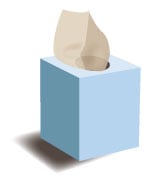 WebMD reports on allergy facts and statistics, based on the best available data:
WebMD reports on allergy facts and statistics, based on the best available data:
- Percentage of the U.S. population that tests positive to one or more allergens: 55%.
- Number of people in the U.S. who have either allergy or asthma symptoms: 1 in 5.
- Rank of allergies among other leading chronic diseases in the U.S.: 5th.
- One estimate of the annual cost of allergies to the health care system and businesses in the U.S.: $7.9 billion.
- Number of workdays lost each year as a result of hay fever: 4 million.
- Number of weeks by which the ragweed pollen season has increased in the last 10 to 15 years, likely as a result of global warming: 4.
- Odds that a child with one allergic parent will develop allergies: 33%.
- Odds that a child with two allergic parents will develop allergies: 70%.
- Number of ER visits in the U.S. caused by food allergies each year: 30,000.
- Percentage of the people in the U.S. who believe they have a food allergy: up to 15%.
- Percentage of the people in the U.S. who actually have a food allergy: 3% to 4%.
- Percentage of our lives that we spend indoors: 90%.
- Degree by which levels of indoor pollution in U.S. homes exceed levels of outdoor pollution: 2 to 100 times, depending on factors such as whether the residents smoke.
- Percentage of U.S. households with one or more dogs: 39%.
- Percentage of U.S. households with one or more cats: 36%.
- Percentage of all U.S. households with detectable levels of dog and cat dander: 100%.
- Increase in the prevalence of asthma in the U.S. between 1980 and 1994: 75%.
- Increase in the prevalence of asthma in U.S. children under age 5 between 1980 and 1994: 160%.
- Percentage of annual ER visits in the U.S. caused by asthma: 25%.
- Percentage of people hospitalized for asthma who are children: About 44%.
- Number of deaths each year in the U.S. from asthma: About 5,000.
- Number of people with chronic allergy-like symptoms — runny nose, congestion and cough — but who have nonallergic rhinitis instead: 1 out of 3.
